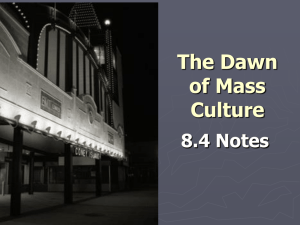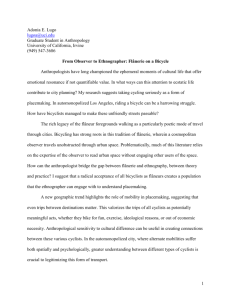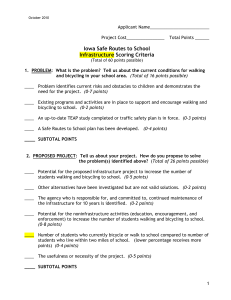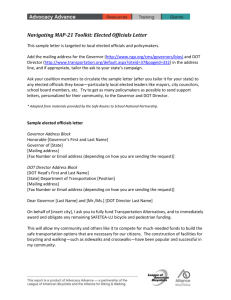Estimating Bicycling Demand
advertisement
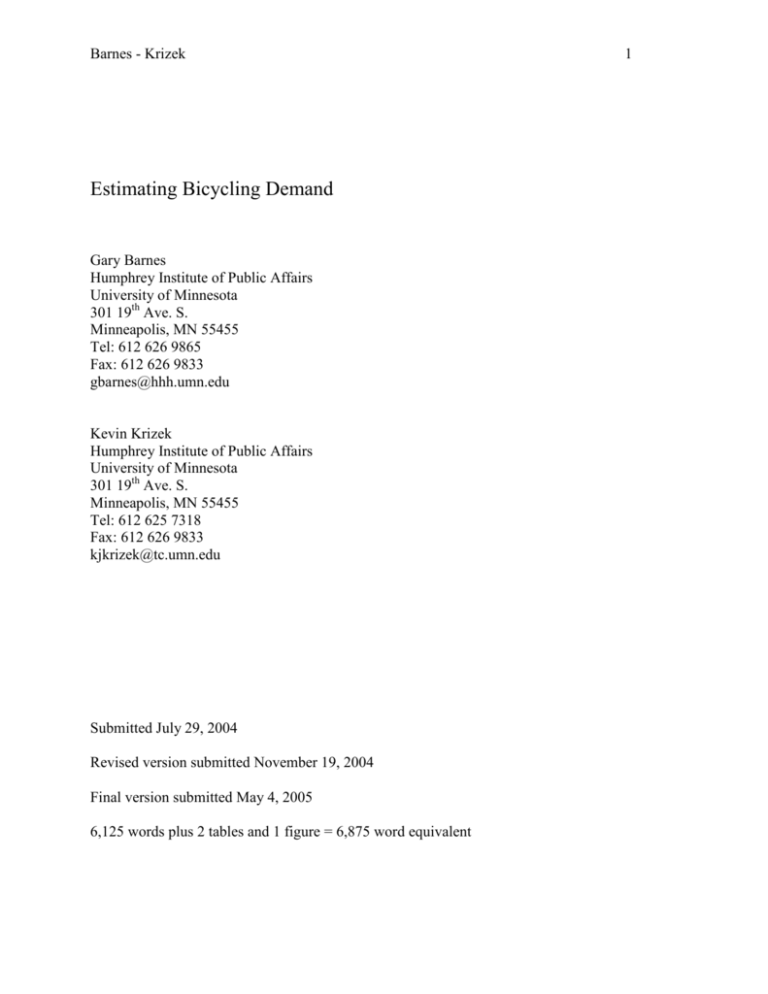
Barnes - Krizek Estimating Bicycling Demand Gary Barnes Humphrey Institute of Public Affairs University of Minnesota 301 19th Ave. S. Minneapolis, MN 55455 Tel: 612 626 9865 Fax: 612 626 9833 gbarnes@hhh.umn.edu Kevin Krizek Humphrey Institute of Public Affairs University of Minnesota 301 19th Ave. S. Minneapolis, MN 55455 Tel: 612 625 7318 Fax: 612 626 9833 kjkrizek@tc.umn.edu Submitted July 29, 2004 Revised version submitted November 19, 2004 Final version submitted May 4, 2005 6,125 words plus 2 tables and 1 figure = 6,875 word equivalent 1 Barnes - Krizek 2 ABSTRACT Simple and reliable tools for estimating and predicting the amount of bicycling in an area would be useful for a variety of investment and policy decisions. Previous efforts to develop such tools have typically tried to develop demand estimates from basic descriptors of the population, land use, and bicycling facilities of an area. This paper takes an alternative approach using the idea of deriving estimates of the likely range of total bicycling demand in an area based on census commute to work data. There are three important contributions. The first is a general discussion of the total amount of bicycling in the United States and how it varies across places, based on a number of surveys and some original data analysis. The second is the development of an argument that predictive models based on land use and transportation factors are unlikely to ever be very accurate or useful due to a number of intractable problems. Third, a simple model is developed for estimating a range of current levels of bicycling in a given geographic area, with reasonable and known accuracy and using easily available data. While this model stops short of predicting future bicycling levels, or demand on specific facilities, it is an important first step in reaching these objectives. There is such a high degree of local variation in bicycling rates in the U.S. that attempts to directly predict future bicycling levels without accounting for current levels are unlikely to be consistently successful. Barnes - Krizek 3 INTRODUCTION Transportation investment decisions often require estimates or predictions of the amount of bicycling in a given area, as well as how this amount depends on facilities and other conditions. Despite a variety of publications describing efforts to model bicycle demand, no modeling technique or set of parameter values or even rules of thumb has emerged as definitive. A first step in thinking about how to model bicycling demand is to understand the types of questions that the model might be used to answer. Porter, Suhrbier, and Schwartz (1) list three major questions, paraphrased here: 1. How many people will use a new facility? 2. How much will total demand increase given an improved facility or network? 3. How does bicycling affect public objectives such as congestion and air quality? The last of these could be expanded to include the benefits to cyclists themselves, such as improved health and recreational opportunities. The answer to this question could be useful politically, in justifying public spending on bicycle-related projects. The answers to the first two questions are likely to be more useful for technical analyses, in prioritizing projects given limited resources. Another way of approaching the problem is to note that there are three different demand prediction objectives: 1. Predicting the total amount of bicycling in an area or on a facility, 2. Predicting the marginal amount that total demand will change given a change in facilities or policy, and 3. Identifying areas where inadequate facilities appear to be holding the level of bicycling below its potential, as in the “Latent Demand” approach (2). In principle, a model that explains the total amount of bicycling as a function of “basic” factors including demographic, policy, and facility variables would answer all of these questions at the same time. Most past work has taken this kind of approach. Federal Highway Administration (3) and Texas Transportation Institute (4) completed major surveys of nonmotorized modeling techniques in the late 1990s; the majority of the efforts they describe focused on predicting either commute shares or total bicycle travel by reference to these types of basic factors. More recent work such as Dill and Carr (5) has also used this methodology. Results of these efforts have been mixed. While certain demographic and geographic variables routinely emerge as important, evidence linking bicycle facilities and policies to levels of cycling has proven hard to come by; Dill and Carr note that there is somewhat of a consensus that such evidence has not been established. In general it has been hard to find strong relationships because the differences in levels of bicycling across different areas can be very large in relative terms, much larger than can reasonably be explained by differences in the bicycling environments. Unmeasured factors, perhaps cultural or historical, appear to play an extremely large role in determining the level of cycling in an area. Barnes - Krizek 4 A second, less common type of demand prediction method uses census commute-to-work shares, often combined with other data, to provide an area-specific baseline of bicycle usage; this can help to neutralize or perhaps proxy for some of the unmeasured factors that can have such a large impact on demand. Epperson (6) in Miami used census data combined with demographic factors for estimating bicycling demand generally. Goldsmith (7) in Seattle used census data combined with local information to predict likely changes in bicycle commuting due to facility improvements. This paper approaches the demand prediction problem more from this second philosophical perspective; that is, to use known information about commuter bicycling to develop estimates of total bicycling levels in an area. These estimates would provide an areaspecific baseline that could then be supplemented with other information to predict how the number might change under various conditions. There are three major steps in developing a tool based on this approach. The first part of the paper describes the results of several surveys and other measurements of general bicycling demand completed over roughly the last decade. The aim is to bring together the results of these many different measurements, to show that the statistics are all roughly consistent when their differing time frames are considered, and place general bounds on the sizes of numbers that are likely to be observed. The second part of the paper argues that, for a variety of reasons, the common demand modeling objective to develop relationships between facilities and use by comparing different geographic areas is not likely to provide models that are consistently successful. The reasons are derived in large part from some problematic findings from our own attempt to develop a demand model for the Twin Cities area. The third part of the paper discusses a simple model relating current total bicycling rates to census commute to work shares. We describe estimates of this relationship across several geographic scales. This method is advantageous because it is simple to estimate, understand, and explain to policymakers, and has a known range of accuracy. THE AMOUNT OF BICYCLING IN THE U.S. This section describes the results of several surveys measuring general bicycling demand that have been completed over roughly the last decade. The primary objective here is to bring together the results of many different measurements, to show that they are roughly consistent when their differing time frames are considered, and to place general bounds on the sizes of numbers that are generally likely to be observed. A secondary objective is to demonstrate how a conceptual framework in which there is a distribution of bicycle riding frequencies over the population can reconcile the various measures of bicycling demand. Measurements of Bicycling Frequency Most of the available information about the amount of bicycling addresses the number of cyclists, as opposed to number of trips or miles of cycling. Because of the amount of information that is available about riding frequency, we use this as our measure of bicycling demand. The end of this section briefly addresses some other measures. Barnes - Krizek 5 The surveys and other sources that address the frequency of bicycling produce a wide variety of results. Each source asks about a different time frame; the number of people who cycle in a week will be larger than the number who ride in a day. A key distinction to keep in mind is that (empirically) adults are considerably less likely to ride a bike than are children, regardless of the time frame being considered. These two groups must therefore be studied independently to avoid confusion or ambiguity. This is generally not an issue with most bicycling surveys, which tend to focus on adults, but it is a factor in deriving numbers from general travel data collection surveys. In the ensuing discussion and tables, the data refer to adults 18 years and older. We derived measures of the number of people who ride a bicycle in a given day from two sources. The Twin Cities Travel Behavior Inventory (TBI) from 2001(8) was a daily diary survey of about 5,000 households in the Minneapolis-St. Paul metropolitan statistical area (MSA). This was done primarily during the spring and summer. The National Household Travel Survey (NHTS) of 2001 (9) was a similar survey done over the entire United States; roughly 25,000 households were sampled in the general survey that we examined for this study. This survey was done over an entire year, which makes it possible to measure seasonal variations. Both of these surveys involved households keeping travel diaries on a randomly assigned day; these days were spread throughout the week, and throughout the year for each geographic area. The NHTS also identifies households in about 20 Metropolitan Statistical Areas (MSAs) and 34 states, allowing us to calculate averages for these areas. It should be noted that samples for many of these were fairly small, so the number for a specific area could be well off the true value. However, this probably gives a reasonable estimate of the range of values that might be observed over areas with large populations. The NHTS also asks about whether the individual completed bicycle trips during the last week; again it is possible to calculate this at the level of specific MSAs and states. There are several national bicycling-specific surveys addressing longer time periods than a week. Rodale (10) reports on U.S. surveys done in 1992 and 1995. They report the percent of adults bicycling in the last year, and it is possible to calculate the percent bicycling in the last month. The Bureau of Transportation Statistics (11) conducted a U.S. survey asking about riding done during the summer of 2002, defined as a three-month period. A more general Minnesota Department of Transportation (Mn/DOT) survey (12) from 2003 asks whether respondents bicycle for exercise, but does not ask about frequency. The 2002 National Sporting Goods Association survey (13), asks about participation in a variety of recreational activities; here the standard is riding a bike at least 6 times in the year. Finally, the U.S. Census asks detailed questions, including mode choice, about the commute to work of about 10% of the residents of the U.S. These are summarized for use by transportation planners in the Census Transportation Planning Package (14). These data have the advantage of being by far the largest and most geographically comprehensive bicycle-related data sample available. The disadvantage is that they capture only commute to work trips, which are a small minority of all bicycling trips (11). Table 1 summarizes the results from the sources described here and in the preceding paragraphs. Some people ride almost every day; others may only ride once a year. The longer the time frame being considered, the more people will have ridden at least once. It is possible to divide the population into different frequencies of riding in a manner consistent with the above numbers derived from different time frames. If each member of a group of people has a Barnes - Krizek 6 probability p of riding a bicycle in a given day, then the expected fraction n of that group that will ride at least once in a span of x days is given by the formula: n = 1 – px (1) Groups with different riding probabilities p will generate different expected numbers of riders over a given time frame, and the numbers from each group can then be summed to arrive at a population total. Table 2 shows an example of how the population can be allocated to groups with different probabilities of riding in a given day, in order to match known overall population bicycling rates over different time frames. These riding probabilities and population frequencies are mathematically consistent with about 1% of adults riding in a given day, 5.3% in a week, 16% in a month, 29% in a summer, and 40% in a year, and with 50% “sometimes” riding, although not necessarily in a given year. The numbers deriving from the population frequencies do not exactly correspond to the national averages over the medium time frames. This is probably because the national averages may be slightly overestimated in these cases. Intermediate time frames such as “this week” or “the last month” contain some room for personal interpretation; a person who rode ten days ago might consider that to be close enough to count as part of the last week. Evidence that this is happening can be seen in the fact that the fraction of adults in the NHTS who report riding in the last week is more than seven times the number that rode on their survey day. Given that survey days covered all days of the week, and that every day will not be a completely new set of people, this result should be logically impossible. If this frequency table is roughly right, there are some interesting implications. The top four lines are the people who ride at least once every ten days. They are 2% of the adult population, or 5% of the adults who cycle in a given year. But they constitute 42% of the riders on any given day. That is, the 5% most active cyclists generate about half the riding days, the other 95% generate the other half. Because so many of the trips are generated by such a small number of people, a relatively small part of the population can have a big impact on the total amount of cycling. If 4% of the public were in the “frequent” category, rather than the 2% that probably are now, that could conceivably lead to a 40% increase in the total amount of biking. Something like this may be what is happening in areas that generate very high levels of bicycling. Evidence from the TBI and NHTS, although not exactly consistent, shows that on the average day when an adult rides a bicycle, he or she rides about 40 minutes. The NHTS also reports distances, however these seem extremely unreliable. Considering the total daily ride durations in these data, assuming plausible average speeds, and assuming that those people who ride longer times will also go faster, gives a likely daily average distance of perhaps 7 to 10 miles. Those people riding more than 60 minutes in a day, while they are only a quarter to a third of all cyclists in a given day, ride about two thirds of the total miles. MODELING BICYCLING DEMAND Traditional approaches to modeling bicycle demand are derived from the standard methods used for forecasting auto travel. That is, they start from basic information about the people and the Barnes - Krizek 7 transportation environment in an area and use this in some way to predict an amount of bicycle travel, either directly, or as the solution to a mode choice problem in a larger travel model. This section discusses some problems with using this approach to model bicycling demand, some of which appear intractable. The arguments are based in part on some of the facts about bicycling discussed in the previous section, and in part on some preliminary findings from our own attempt to estimate a demand model for the Twin Cities area. While this model is not described here, in part due to the lack of useful results, it is used to illustrate some of bicycle demand modeling more generally. There are several reasons why a bicycling demand model derived from basic information about land use, demographics, and the transportation system is likely to be of limited utility. These can be illustrated in part by our own attempt at developing a demand model, in which we found a statistically significant result that off-road paths were associated with lower per person levels of bicycling for nearby residents. This result makes no sense intuitively; at worst residents should ignore the paths. Empirically, Davis (15) found that off-road facilities in the Twin Cities were in fact much more intensively used in all parts of the city than other options such as streets and on-street bike lanes. Our result was not due to an obviously underspecified model; a wide variety of demographic and land use variables were included in the regressions. There seem to be four major possible reasons for this problematic outcome. One is a possible shortcoming in the analysis, that possibly the way that facilities were defined did not correspond to how people perceive them. For example, many of the suburban “off-road” facilities run next to busy highways, with all the associated crossing of driveways and roads. They are off-road in the sense that there is a barrier separating them from the road, but they are not off road in the sense of eliminating potential conflicts, or of being appealing to ride on. However, the development of a more general measure of the bicycling environment, going beyond simple number of miles of facilities, is a difficult problem for many reasons. A major reason is that a large fraction of bicycle riding is recreational. Intuitively, the sorts of land use and transportation facilities that would be ideal for utilitarian riding (dense development, a grid network, etc.) seem very different from what would be ideal for recreational riding (infrequent intersections, density of little importance). That is, the value of a facility may depend on the use to which it is being put. As a related point, the skill level of the rider likely also influences perceptions of the riding environment. These are significant conceptual difficulties, since it would seem that there is no single land use-transportation type that is ideal for all bicycling activities or people, and hence no unambiguous way of defining the “quality” of the environment. The second problem with this sort of model is that there are large and seemingly random differences from one place to another. In one area we analyzed in Minneapolis, 16% of the adults made bike trips on the day they were surveyed, while the rate in many other areas was 0%. Even across entire metropolitan areas or states, differences of a factor of ten can be seen, as shown in the previous section. There are some well-documented population and land use characteristics that are associated with higher levels of bicycling. For example, people with college educations are more likely to bicycle, but the difference is on the order of a factor of two compared with less educated people. A similar difference exists for factors such as income, development density, and gender. None of the known factors, alone or together, can come close to explaining why people in some Barnes - Krizek 8 places are ten or more times as likely to ride bikes as people in other places. Other attitudinal and possibly historical factors seem to dwarf the effect of the factors that planners and policy makers can control. Because the impact of the unobservable variables are so big relative to the variables of interest, it seems highly likely that what is being observed, both in our model and in others, is the effect of attitudinal variables acting on policy variables through spurious correlations. Our model seems to have been driven by geographic spikes in riding that happened to be positively correlated with some facility measures and negatively with others, but that in a causal sense had little or nothing to do with any of them. It seems possible that these types of spurious correlations might also be driving the results of other work of this type in the literature, given the typically low explanatory power of these models. A third problem is that low levels of bicycling cause the range of sampling error to be many times larger than the sample mean for any realistic sample size. The effect is that the regression is trying to match measured variable values that could be off by a factor of five or more from their true values. A sample of 1,000 people would yield 9 cyclists on a given day at the national average level; the 95% confidence interval for this sample ranges from 3 to 15 cyclists. This is a large difference in relative terms, and observed extremes could easily just be sampling aberrations. Yet these inaccurate measurements could strongly influence the estimated parameter values. Finally, there is always the problem, noted by Dill and Carr (5) and others, that even a positive correlation between riding and facilities could be causation in the other direction, that is, the large number of cyclists creating the political climate to build the facilities, rather than the facilities encouraging more riding. For example, bike lanes in some cases may be a response to existing situations such as bikes interfering with traffic. In these cases retrofitted lanes will often be associated with high levels of cycling after they are built. By contrast, lanes in some newer cities in California do not seem to have high riding levels (5), possibly because they were designed into new roads, that is, built in anticipation of riding rather than in response to it. Seemingly the only way around these problems would be to study the same geographic area over a period of time as facilities change. The relevant question for policy is not comparing people living at location A to different people living at location B, but rather comparing the people at A to themselves as the provision of facilities changes over time. This would be an expensive prospect using surveys; development of a low cost method of counting bikes over a large number of different streets and bike facilities, such as is outlined in Davis (15), would be of great value for this purpose. A MODEL OF TOTAL BICYCLING DEMAND This section outlines a simple “sketch planning” method for estimating the number of daily bicyclists in an area using easily available data from the CTPP (14). An estimate of the current number of bicyclists in an area could be used for general political purposes, justifying expenditures by reference to the number of bicyclists and the benefits that they receive from cycling. However, the more interesting problems for planners are predicting how the number of cyclists will change as a result of a facility or other improvement, and knowing how many cyclists use or will use a specific facility. Barnes - Krizek 9 While this model does not directly address these questions, we believe that it is still useful because the answers to these questions will in general need to be conditioned on the number of current bicyclists. This is not to say that the number of cyclists in an area cannot grow; the examples of many high-cycling cities show what is possible. However, in general any growth will probably be gradual rather than abrupt, and will likely depend on continued improvement of the cycling environment. Thus the rules of thumb developed here are not intended to represent permanent bounds on possible cycling levels, but only to provide a range of likely short-term changes. Similarly, while use of a given facility will probably depend on a host of site-specific factors, in most cases it will also be limited in the short term by existing bicycling habits among the surrounding population. A thousand daily users may be realistic in an area where 2000 people a day currently ride bikes; it is probably not realistic in an area where 200 do. This is not to say that facilities are only justifiable in areas that already have a lot of cyclists, or that a facility can’t increase the number of cyclists. The point, again, is only to provide an empirical basis for developing realistic expectations regarding short term results. The basic assumptions motivating this analysis are that a large fraction of total bicycling is done by a small fraction of cyclists who ride frequently, as discussed earlier, and that many of these frequent riders are bicycle commuters observed in the census commute to work data. The hypothesis that we test in this section is that the basic riding frequency table described in the previous section will hold more or less across different areas. Thus an area with many commuter cyclists will also have more total cycling, and an area with few commuters will have little total riding. In other words commuting by bike, while it is a small fraction of the total bicycling in a given area, can still be used as a “leading indicator” of what might be happening with other types of cycling. Three different geographical divisions are examined to study this issue. First is a set of 15 MSAs for which we could match CTPP commute to work shares with NHTS (9) daily bicyclist counts. Next are states; there are 34 for which both census and NHTS data were available. Last is an analysis of 66 “zones” of the Minneapolis-St. Paul MSA using data from the TBI (8), showing that the basic principle still works at this very different geographic scale. The TBI and NHTS, like most travel diary data, are limited by small sample sizes for specific geographic areas. Because of this and the low level of cycling, the expected number of cyclists in the sample for a given area could vary by a factor of 10 or more from the low to high end of the range. Ordinary measures of goodness of fit have little meaning in this sort of environment; we focus instead on more heuristic measures such as the number of observations that fit within the predicted confidence interval. Metropolitan Statistical Areas Combining census data with our NHTS analysis produced 15 MSAs for which we had both commute to work shares by bike and total percent of adults biking on their survey day. The commute shares ranged from 0.1% (Cincinnati and Dallas) to 1.4% (Sacramento). The daily adult biking shares ranged from 0.18% (Houston – although this is probably a sampling problem as 4.2% rode during the previous week), to 2.45% (Portland, with Sacramento close behind at 2.25%). We estimated parameter values as shown in equation 2; the R squared for this equation was about 0.7. Barnes - Krizek 10 A = 0.3% + 1.5*C (2) where A = % of adult population who bicycle in a day C = bicycle commute share % This equation can be used to generate a predicted total riding share for each city. Given this predicted share and the NHTS sample size, a 95% confidence interval of expected number of adult bicyclists in the sample can be calculated assuming a binomial function. For 14 of the 15 cities, the actual number of bicyclists fell within this confidence interval. The one exception was Chicago, which generated 19 actual cyclists compared to a predicted level of 9. The performance of this model at predicting the observed number of cyclists for the cities with the biggest samples (and presumably the most reliable numbers) is quite good, again with the exception of Chicago: New York had 20 predicted and 23 actual, Los Angeles had 23 – 22, San Francisco 21 – 19, and Boston 9 – 7. At the low and high ends of the commuter cyclist ranges, Cincinnati had 1 predicted and 1 observed, Dallas was 3 – 3, Portland was 6 – 10, and Sacramento 9 – 8. Portland was among the worst-predicted cities, but still within a 95% confidence interval. Overall, as Figure 1 shows, the hypothesis that overall bicycling rates will correlate with bicycle commuting rates seems to be supported; indeed the correlation seems quite strong at this geographic level. The equation is also exactly consistent with the U.S. as a whole (0.4% commute share, 0.9% total daily cyclists), and with a division into larger and smaller cities, in which the same figures are observed. States There were 34 states with data from both the census and the NHTS. Alabama had the lowest bicycle commute share at 0.07%, Oregon the highest at 1.07%. Arkansas has the lowest rate of total bicycling at 0% (again, a sampling problem as 3.4% rode during the preceding week), and Florida the highest at 2.21%. Equation 3 shows the estimated parameter values, which are slightly different from that observed at the MSA level. The R squared of this model was about 0.3. A = 0.4% + 1.1*C (3) Using either these parameter values or those derived from the MSA level, the same predictive results emerge. Of the 34 states, 30 have actual counts within a 95% confidence interval of their predicted values; the exceptions are all underpredicted. Of the states with good sample sizes (over 1000) about half were predicted with good accuracy (less than one standard deviation), the other half were farther off the mark, with predictions both too high and too low. Barnes - Krizek 11 Twin Cities Zones The final level of analysis considered variations within the Minneapolis-St. Paul MSA, using 65 “zones” that had been defined for a different project. These were largely based on political boundaries, with the two central cities divided into a number of zones based on natural and artificial divisions and neighborhood characteristics. Populations of the zones ranged from about 10,000 to 30,000. While this analysis was based on the TBI, which was a large local survey, there were still only 139 adults in the survey who made bike trips (whose home location could be mapped to a zone in this area), and a third of these were in four zones in Minneapolis. Thus the estimated bicycling rates for most of the zones are extremely unreliable. The results of this regression are shown in equation 4. A = 0.6% + 2.5*C (4) The relatively high slope and intercepts of this equation are likely a reflection of the “outlier” nature of the Twin Cities compared to the areas on which the previous two regressions were based. That is, depending on the measurement, the Twin Cities have an overall adult bicycling rate of 1.6% - 2%, which is quite high compared to their bike commute share of 0.4%. Thus overall bicycling here is about twice as high as would be predicted by the earlier regressions; given this perhaps it is logical that the estimated parameter values with data drawn from this region would be about twice as high as well. In most of the zones the sample size was too small to present an interesting prediction problem; that is, for these zones both the prediction and the actual count were either one or zero. For those 15 zones where the predicted number was two or more, 12 were predicted within a 95% confidence interval, while three had actual values in excess of the predicted range. Although the high bicycling zones were not predicted accurately in absolute terms, the general relationship between commuting and total bicycling held in general. The six zones where commuting by bike exceeded 2% generated six of the seven highest rates of overall daily bicycling. CONCLUSION On any given day, roughly 1% of the adults in the United States ride a bicycle. Over large geographic areas such as metropolitan areas or states, this number could range roughly between about 0.3% and 2.5%. Over smaller areas such as specific parts of metropolitan areas, the range could go as high as 15%. These variations are far larger than can be reasonably explained by differences in formal policies and facilities. It seems that local or even “subcultural” attitudes and perhaps history play a very substantial role in the perception of bicycling as an appealing or even “normal” thing for an adult to do, although without further study it is difficult to imagine how these factors might exert their influence. When the actual percentage of cyclists in an area is not known, it can be estimated with reasonable accuracy by considering the bicycle commute to work share. A “most likely” value would be 0.3 percent plus 1.5 times the commute share; this was the best fit at the MSA level, and also describes the U.S. as a whole. Figure 1 shows lines representing rough boundaries on Barnes - Krizek 12 the observed values for daily cyclists, as they relate to bicycle commute shares at the MSA and state level. These lines appear in fact to represent three distinct relationships between these two variables that are observed in the data, but at this point this must be considered a sampling coincidence. The model described here has important practical advantages. It is simple enough to be understandable to makers of funding decisions, and provides a known range of possible outcomes derived from a wide variety of locations and different geographic scales. However, it does fall short of the modeling ideal of directly describing a relationship between the provision of bicycling facilities and the amount of bicycling that will take place. The formulas we derive simply describe the amount of bicycling that is currently taking place; they do not relate this amount in a causal way to explanatory factors, or explain how it might change. We believe that this compromise is necessary because of the findings described in the first two parts of this paper. By helping the planner to estimate a range of the number of bicyclists currently riding in a given geographic area, the model establishes a baseline that can be used to develop more informed estimates about how this number might change given a change to the facilities or cycling environment. Such a baseline is necessary for any more detailed estimates or predictions because there is such a high degree of variation in bicycling demand levels in different locations. This model represents a first step in such a methodology; the question of how to get from a general estimate of current bicycling levels to predictions about general or facility-specific future levels is left to later research. More qualitative research to better understand the “outliers” could also be useful. Some MSAs and states have very high or low levels of bicycle commute shares and/or daily adult bicyclists. Over such large populations, this seems unlikely to be very much due to demographic differences. More detailed case studies of places that generate these very high or low rates of bicycling could be enlightening, especially if “soft” factors such as culture and attitudes can be probed in some systematic way. ACKNOWLEDGEMENTS The authors would like to thank the National Cooperative Highway Research Program and the Minnesota Department of Transportation for providing financial support for this research. Barnes - Krizek 13 REFERENCES 1. Porter, C., J. Suhrbier, and W. Schwartz. Forecasting Bicycle and Pedestrian Travel: State of the Practice and Research Needs. In Transportation Research Record: Journal of the Transportation Research Board, No. 1674, TRB, National Research Council, Washington, D.C., 1999, pp. 94-100. 2. Landis, B. Using the Latent Demand Score Model to Estimate Use. In Pro Bike/Pro Walk 96 Resource Book. Presented at the Ninth International Conference on Bicycle and Pedestrian Programs, Portland, Maine, September 1996, pp. 320-325. 3. U.S. Department of Transportation. Guidebook on Methods to Estimate Non-Motorized Travel. Publication FHWA-RD-98-166. FHWA, U.S. Department of Transportation, 1999. 4. Turner, S., A. Hottenstein, and G. Shunk. Bicycle and Pedestrian Travel Demand Forecasting Literature Review. Publication 1723-1. Texas Transportation Institute, Texas A & M University and Texas Department of Transportation, 1997. 5. Dill, J., and T. Carr. Bicycle Commuting and Facilities in Major U.S. Cities: If You Build Them, Commuters Will Use Them. In Transportation Research Record: Journal of the Transportation Research Board, No. 1828, TRB, National Research Council, Washington, D.C., 2003, pp. 116-123. 6. Epperson, B. Demographic and Economic Characteristics of Bicyclists Involved in BicycleMotor Vehicle Accidents. In Transportation Research Record: Journal of the Transportation Research Board, No. 1502, TRB, National Research Council, Washington, D.C., 1996, pp. 58-64. 7. Goldsmith, S. Estimating the Effect of Bicycle Facilities on VMT and Emissions. Seattle Engineering Department, Seattle, Washington, n.d. 8. Travel Behavior Inventory 2000. Metropolitan Council, Minneapolis, Minnesota. www.metrocouncil.org/planning/transportation/TBI_2000.htm. Accessed July 22, 2004. 9. National Household Travel Survey 2001. U.S. Department of Transportation. http://nhts.ornl.gov/2001/index.shtml. Accessed July 22, 2004. 10. Pathways for People, II. Rodale Press, Emmaus, Pennsylvania, 1995. http://safety.fhwa.dot.gov/fourthlevel/pdf/Pathii.pdf. Accessed July 6, 2004. 11. National Highway Traffic Safety Administration, and Bureau of Transportation Statistics. National Survey of Pedestrian and Bicyclist Attitudes and Behaviors. 2003. http://www.walkinginfo.org/survey2002.htm. Accessed July 6, 2004. 12. MarketLine Research, Inc. Minnesota Department of Transportation Mn/DOT Statewide Omnibus Study 2003/2004. www.dot.state.mn.us/restareas/Research/pdf/03-04OmnibusRpt.pdf. Accessed July 6, 2004. 13. National Sporting Goods Association, “Sports Participation in 2001: Series I.” In Statistical Abstract of the United States: 2003. U.S. Census Bureau, Washington, D.C., 2003, p. 778. 14. U.S. Census Bureau. United States Census 2000. In Census Transportation Planning Package: Census of Population and Housing. CD-ROM. U.S. Census Bureau, American Association of State Highway and Transportation Officials, Washington, D.C., 2000. 15. Davis, G., and T. Wicklatz. Sample-Based Estimation of Bicycle Miles of Travel (BMT). Publication Mn/DOT 2001-23. Minnesota Department of Transportation, 2001. Barnes - Krizek LIST OF TABLES AND FIGURES TABLE 1 Measures of Adult Bicycling Frequencies TABLE 2 Possible Population Distribution of Bicycling Frequencies FIGURE 1 Daily Bicyclists and Commute Share, Combined MSAs and States 14 Barnes - Krizek 15 TABLE 1 Measures of Adult Bicycling Frequencies Source and Area Measure Average Range TBI, Twin Cities MSA NHTS, U.S. Total % per day 1.4% 0.9% .56% winter .88% spring-fall 1.1% summer 0.2% - 2.4% 0.0% - 2.2% 4.5% - 12.7% 3.5% - 12.4% 16.6% - 21.2% NHTS, US MSAs NHTS, US States NHTS, U.S. Total NHTS, US MSAs NHTS, US States Rodale BTS Rodale NSGA Mn/DOT U.S. Census U.S. Census, MSAs U.S. Census, states % per week % per month % per summer % per year % 6 times per year % that ever ride Commute to work % 6.7% 27% 10.7% 50% 0.4% 37% - 46% 0.1 - 1.4% 0.1 - 1.1% Barnes - Krizek 16 TABLE 2 Possible Population Distribution of Bicycling Frequencies Frequency of cycling % of adults 3 of every 4 days 1 of every 2 days 1 of every 4 days 1 of every 10 days 1 of every 20 days 1 of every 50 days 1 of every 100 days 1 of every 200 days Never 0.1% 0.2% 0.5% 1.2% 3% 10% 15% 20% 50% Barnes - Krizek 17 0.5% + 3(C) 3.0 Daily Adult Bicyclist % 2.5 0.3% + 1.5(C) 2.0 1.5 0% + 1 (C) 1.0 0.5 0.0 0.0 0.2 0.4 0.6 0.8 1.0 1.2 1.4 1.6 Bicycle Commute Share % FIGURE 1 Daily bicyclists and commute share, combined MSAs and states
